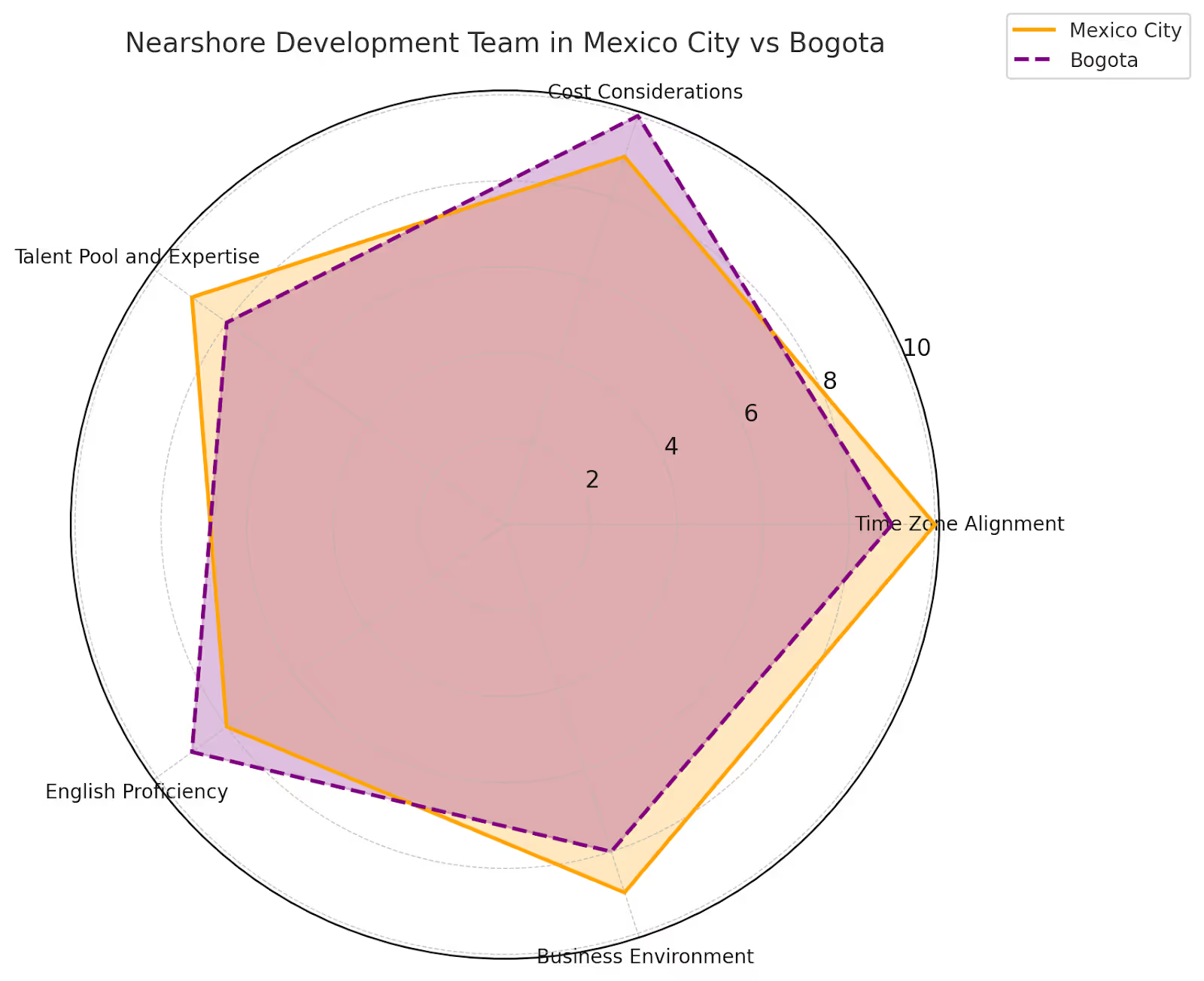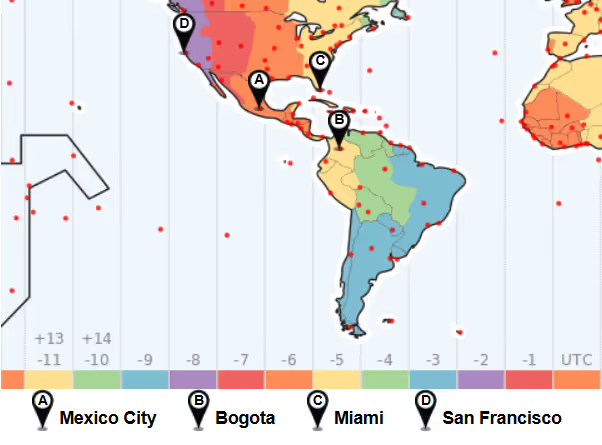Latin America is the best nearshore option for U.S. companies. Among the top destinations in the region, Mexico City and Bogota stand out for their strong technology ecosystems, competitive rates, and business-friendly environments.
In this blog, we'll break down the key differences between nearshore development teams in Mexico City and Bogota, from cost and time compatibility to talent availability and work culture. Whether you're a startup looking to scale or an enterprise looking to streamline operations, this comparison will help you choose the nearshore partner that best fits your goals.
Learn more about nearshore staff augmentation.
Nearshore development team to Mexico City vs. Bogota
When choosing a nearshore development team, factors such as time zone alignment, cost, talent availability, English proficiency, and business environment play a critical role. Mexico City and Bogota are two of the most attractive locations in Latin America for U.S. companies looking to outsource software development. The following radar chart provides a comparative overview of these two cities based on key criteria.

The chart evaluates five key aspects: time zone alignment, cost considerations, talent pool and expertise, English proficiency, and business environment. We will examine each of these factors in detail below.
Time Zone Alignment
One of the biggest advantages of nearshore development teams is that they work in similar time zones, allowing for real-time collaboration. For this reason, Latin America is a top choice for U.S. companies, with Mexico City and Bogota standing out for their close overlap with U.S. business hours.
Mexico City: Mexico City, which operates on Central Time (CT), is ideal for U.S. businesses. It is only one hour behind Miami, making it easy to schedule daily meetings and collaboration without time conflicts. For West Coast companies, such as those in San Francisco, Mexico City is 2 hours ahead, providing enough overlap for productive morning meetings and collaborative work sessions.
Bogota: Bogota is in the same time zone as Miami, ensuring seamless coordination for East Coast companies and making it especially convenient for meetings, project updates, and real-time collaboration throughout the day. For West Coast teams in San Francisco, Bogota is 3 hours ahead.

Cost Considerations
Below is an approximate cost for a Mexico City and Bogota development team. Please note that values may vary depending on the team’s size, the developers’ experience, the technologies required, etc.
Mexico City: In Mexico City, a junior developer can cost between $1,500 and $2,500 per month, while a senior developer can cost over $4,000 or $5,000. With these ranges, a base team of 4 to 5 developers (including a technical lead and semi-senior roles) is around USD 10,000 to 16,000 per month and can reach more than USD 20,000 if very specialized profiles or additional positions such as DevOps or project managers are included.
Bogota: In Bogota, salaries tend to be slightly lower: a junior developer is around $1,200 to $2,000, while a senior developer can reach $3,500 or $4,500. As a result, a team of 4 or 5 people with a senior leader and semi-senior developers can cost around $9,000 to $13,000 per month, exceeding $15,000 if multiple senior profiles and additional specialized roles are required.
Find out more about nearshore software development: The Complete Guide.
Talent Pool and Expertise
Mexico City: Mexico City has a large pool of IT professionals, with more than 700,000 people working in the sector. Mexico graduates more than 130,000 engineers each year. The city is recognized as a technology hub with a thriving startup ecosystem.
It is also home to an impressive array of world-class universities listed in the QS World University Rankings. Its flagship institution, the National Autonomous University of Mexico (UNAM), has established itself as one of the best universities in Latin America and is ranked 9th in the QS regional rankings.
Bogota: Bogota has emerged as a key player in the technology industry. It is one of eleven Colombian cities to be ranked among the top 1,000 most promising cities for entrepreneurship.
The city has several public and private universities, including the University of the Andes, which is ranked 179th in the world and is widely recognized as one of the most prestigious in Latin America. In addition, 33% of its professionals are trained in STEM disciplines.
English proficiency
English proficiency plays a critical role when working with a nearshore development team as it directly affects communication and collaboration.
Mexico City: Mexico City ranks 87th out of 116 countries and 20th out of 21 countries in Latin America on the EF English Proficiency Index, with a score of 464. Many technology professionals in Mexico City have a working knowledge of English, especially in international companies and startups, but overall proficiency can vary.
Bogota: In Bogota, English proficiency tends to be higher, especially among technology professionals and university graduates. Colombia ranks 74th out of 116 countries and 17th in Latin America, with Bogotá scoring 513 on the EF English Proficiency Index. Colombia has invested heavily in bilingual education, and Bogota, as the country's technology and business hub, attracts talent with strong English skills.
Business Environment
Mexico City: The Mexican government actively supports the technology industry through policies that encourage ICT education and foreign investment, creating a favorable business environment. According to IMCO, 27% of Foreign Direct Investment was related to nearshoring.
In 2023, Mexico surpassed China as the top trading partner of the United States. The combination of competitive labor costs, geographic proximity and preferential market access has fueled the growth of nearshoring, especially in states near the U.S. border.
Bogota: Colombia has implemented several initiatives to support the growth of its technology sector. In Bogota, the country's capital, startups captured 60% of equity investments, equivalent to $267 million, of which 45% went to the fintech sector.
In addition, the city benefits from tax incentives and government funding opportunities for nearshore application development service providers. Bogota was ranked 65th in the Global Startup Ecosystem Index, making it the third most relevant city in South America.
Transparent nearshore development with Teilur Talent
At Teilur Talent, we're redefining international recruitment with a transparent pricing model that puts clients first. Unlike many competitors, we openly disclose our margins, which never exceed 20% of what you pay the candidates. Our goal is to build long-term partnerships based on trust and fairness. We go beyond finding skilled nearshore development teams - we carefully match talent with your company's time zone, values, and mission to ensure a seamless cultural fit and effective collaboration.
Working with Teilur Talent means you can focus on your projects while we handle the complexities of international hiring. We manage payroll, contract compliance, and benefits, making it easy for you to build and grow your nearshore team. Pay us monthly via ACH, and we'll take care of the rest. Our mission is to make nearshore hiring simple, transparent, and effective - so you can confidently scale your team.
Learn more about Teilur Talent's pricing disruption with transparency in recruiting.
FAQ
What is a nearshore development team?
A nearshore development team is a group of professionals located in a neighboring country who offer services such as software development. Their proximity allows for similar time zones and cultural affinities, which facilitates effective collaboration.
What is nearshore development?
The Nearshore development team involves outsourcing tasks to companies in nearby countries to leverage benefits like cost savings, access to specialized talent, and minimal time zone differences.
What does a development team do?
A development team is responsible for designing, developing, testing, and deploying software applications or systems, ensuring they meet the specified requirements and are delivered on time.
What is nearshore vs offshore development?
Nearshore development refers to outsourcing to neighboring countries with similar time zones, while offshore development involves outsourcing to distant countries, often with significant time differences.
Conclusion
Mexico City and Bogota offer exceptional opportunities for building a nearshore development team, with different advantages depending on your priorities. Mexico City offers proximity to the U.S., a strong technology talent pool, and central time zone alignment. Conversely, Bogota offers competitive costs, greater English proficiency, and seamless collaboration for East Coast companies.
Ultimately, the best option depends on your company's budget, time zone requirements, and cultural fit. Partnering with a trusted staffing firm like Teilur Talent can make this decision easier. Our transparent pricing model, with margins that never exceed 20%, ensures you get the best talent at a fair cost. We also align candidates with your company's time zone, values, and mission to ensure a strong cultural fit and efficient collaboration.
To help you make the best decision, use the calculator below to estimate your costs and potential savings. For more details and personalized advice, please contact us.








